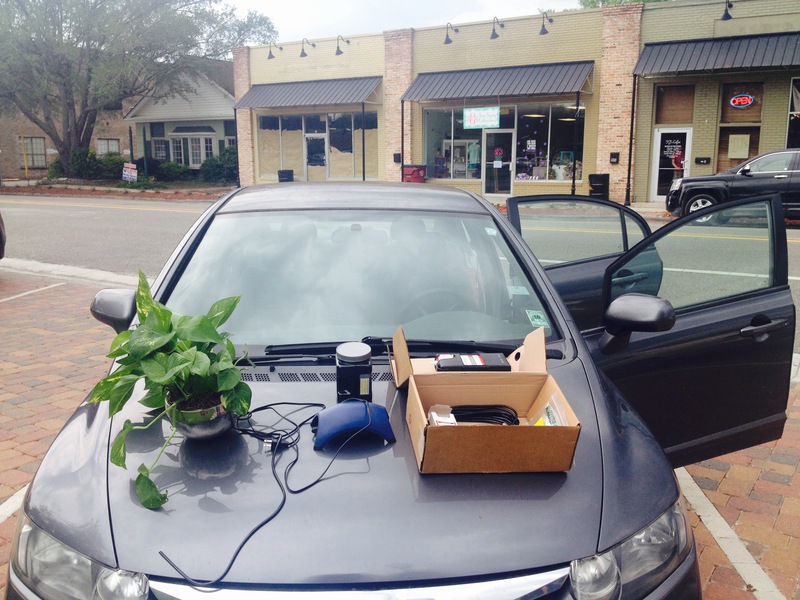
Formaldehyde Test Kit
These formaldehyde testing kits are one part of our multi-pronged Indoor Air quality monitoring efforts.
Goals
Our goal is to measure formaldehyde at typical environmental exposure levels found in homes and workspaces that are irritating and potentially carcinogenic over the long-term, a range from 8-600 parts per billion (ppb) or 0.008 - 0.6 parts per million (ppm), but usually below 150ppb. Read more in Formaldehyde Exposure.
We are also interested in short measurement periods, i.e. an hour or less, so that environmental factors such as ventilation, or the operation of a formaldehyde-generating process or appliance can be correlated.
We would like to produce data comparable between sites and control for false positives (other gasses detected by the method). Being able to calibrate the sensors consistently and inexpensively is therefore critical.
Existing Methods
Electronic Monitoring
Inexpensive electronic monitors are usually not very in the .008-.1ppm range most likely to be found in homes, can be difficult to keep in calibration, and often respond to other gasses as well. A review of current electronic sensing techniques is available through the NIH.
Chemical-reaction-based testing
Passive
We've focused on chemical-reaction-based testing as better documented systems. The two most common methods for detecting formaldehyde in the home involve passive collection of the chemical via a badge (8 to 48 hour test time). These methods require samples to be sent back to the lab for analysis. The send-it-to-the-lab model introduces three problems:
- expensive high pressure liquid chromatography is required at the lab (HPLC, which cost ~$30,000).
- the possibility of contamination during transportation and analysis.
- the cost of testing the transportation process for contamination.
In order to ensure the accuracy of a send-it-to-the-lab test you need to purchase two additional tests, known as a “field blank” and a “trip blank,” to ensure that your sample wasn’t contaminated.
- Three active sorbent samples with Home Air Check costs $217.50.
- Three passive badges with ACS costs $123.
not exactly low cost...
active
An alternative to these passive systems is to actively pump air through a sorbent material (30 minutes to 8 hours) that traps formaldehyde. Pumps can be very expensive, from $500-$3000, but the single-use sorbent materials can be inexpensive. @Nshapiro noticed one such published methodology replacing expensive pumps with calibrated 100-gallon aquarium pumps and using Kitagawa 710 formaldehyde detection tubes, which have a detection range of 10ppb-480ppb with +/-10% accuracy, and a test period of 30 minutes, making them close to meeting our ideal testing range.
The kitagawa tubes cost $7 each in quantity, and the Tetra brand Whisper 100-gallon aquarium pump costs between $25-$55 depending on the retailer.
DIY test considerations
In order to convert the published methodology of an aquarium pump and kitagawa 710 formaldehyde tube into a fully usable kit we need a minimum of: * a method of pump calibration * a means of data recording and verification ...but it would also be useful to have: * a means of easily attaching the Kitagawa tubes to the pump * a timer and automatic shutoff to guarantee proper pumping time
Calibration
The authors failed to mention the actual means of calibration. Based on conversations between @nshapiro and the authors, we know that they used a NIST-traceable Mini-buck calibrator to calibrate pumps in the morning before the test. At $1000 this is clearly not a DIY option.
Rotameters
bubbles
bags
data recording & verification
Verification with network timestamps
In discussions between @warren @nshapiro and @mathew it was decided to try to collect information onto a card that could be photographed along with the test strip for a record. As well as collecting the information all in one place, the photograph, especially when taken with cell phone camera, can be used to make a traceable record of the test. By photographing the test setup before and after and sending that photograph through either the cell network or the internet, the communications containing the photograph will be time-verified by the network, providing 3rd party verification that the test period was within the time period that the test taker claims.
What information to collect?
Here is @Nshapiro's list of information he'd want along with a test result, in groupings by priority:
A
- Date of test
- Test start time (We will probably want start times to be the same-ish, between 1:30pm and 3pm with a preference of 2pm)
- Test end time
- Tube serial number
- Read out on tube (PPM)
- Zip code
- Temperature (F)
- Humidity (can't perform test if under 10 or over 90)
B
- Housing Type: Manufactured, New (less than 5.5 years), Passive Green, Other _____
- My exterior windows and doors have been closed for 24 hours (this is for homogeneity control, easier than having them document each open window/door which would be the other option) (yes/no check box)
- My HVAC system has been blowing air ___% of the time during this test
C * Other observations (much blank space)
cards images....
Complete DIY Kit + parts list
Lending kit + production files

